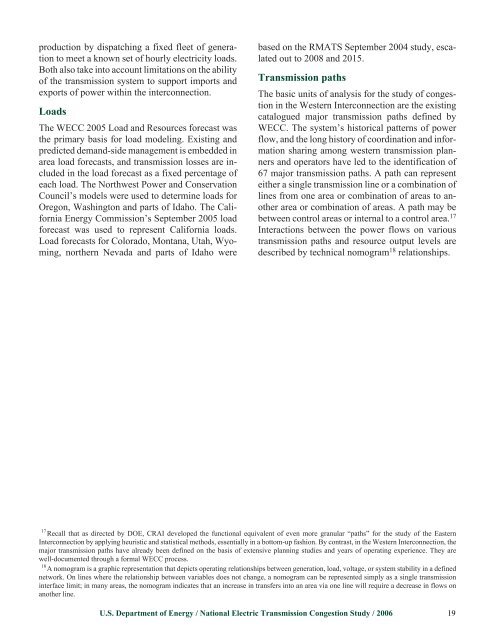National Electric Transmission Congestion Study - W2agz.com
National Electric Transmission Congestion Study - W2agz.com
National Electric Transmission Congestion Study - W2agz.com
Create successful ePaper yourself
Turn your PDF publications into a flip-book with our unique Google optimized e-Paper software.
production by dispatching a fixed fleet of generation<br />
to meet a known set of hourly electricity loads.<br />
Both also take into account limitations on the ability<br />
of the transmission system to support imports and<br />
exports of power within the interconnection.<br />
Loads<br />
The WECC 2005 Load and Resources forecast was<br />
the primary basis for load modeling. Existing and<br />
predicted demand-side management is embedded in<br />
area load forecasts, and transmission losses are included<br />
in the load forecast as a fixed percentage of<br />
each load. The Northwest Power and Conservation<br />
Council’s models were used to determine loads for<br />
Oregon, Washington and parts of Idaho. The California<br />
Energy Commission’s September 2005 load<br />
forecast was used to represent California loads.<br />
Load forecasts for Colorado, Montana, Utah, Wyoming,<br />
northern Nevada and parts of Idaho were<br />
based on the RMATS September 2004 study, escalated<br />
out to 2008 and 2015.<br />
<strong>Transmission</strong> paths<br />
The basic units of analysis for the study of congestion<br />
in the Western Interconnection are the existing<br />
catalogued major transmission paths defined by<br />
WECC. The system’s historical patterns of power<br />
flow, and the long history of coordination and information<br />
sharing among western transmission planners<br />
and operators have led to the identification of<br />
67 major transmission paths. A path can represent<br />
either a single transmission line or a <strong>com</strong>bination of<br />
lines from one area or <strong>com</strong>bination of areas to another<br />
area or <strong>com</strong>bination of areas. A path may be<br />
between control areas or internal to a control area. 17<br />
Interactions between the power flows on various<br />
transmission paths and resource output levels are<br />
described by technical nomogram 18 relationships.<br />
17 Recall that as directed by DOE, CRAI developed the functional equivalent of even more granular “paths” for the study of the Eastern<br />
Interconnection by applying heuristic and statistical methods, essentially in a bottom-up fashion. By contrast, in the Western Interconnection, the<br />
major transmission paths have already been defined on the basis of extensive planning studies and years of operating experience. They are<br />
well-documented through a formal WECC process.<br />
18 A nomogram is a graphic representation that depicts operating relationships between generation, load, voltage, or system stability in a defined<br />
network. On lines where the relationship between variables does not change, a nomogram can be represented simply as a single transmission<br />
interface limit; in many areas, the nomogram indicates that an increase in transfers into an area via one line will require a decrease in flows on<br />
another line.<br />
U.S. Department of Energy / <strong>National</strong> <strong>Electric</strong> <strong>Transmission</strong> <strong>Congestion</strong> <strong>Study</strong> / 2006 19














